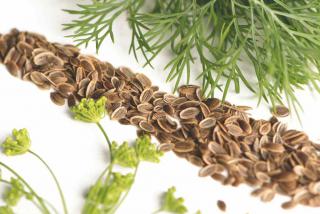

Dill or Anethum graveolens holds its name from the Greek word anethon, “that which grows fast”.
It is an annual plant 3 feet (1 meter) tall, native to Southern Europe and the Middle East.
Dill belongs to the Apiaceae family (or Umbelliferae). This light, ethereal plant easily finds its place in flower beds.
From the earliest reported times of ancient history, dill was used as a spice and a remedy.
The medical papyrus of Erbers (dated about 1500 before Christ) mentions its medicinal properties.
In Bucolics, the poet Virgil described a nymph collecting bouquets of dill.
Today, dill is practically only used as a condiment, especially in Scandinavian countries and Germany, and in France, too, where it is often paired with fish with many culinary preparations, including raw.
Dill infusion: one teaspoon seeds which is about 0.15 to 0.3 oz (4 to 8 g) per cup boiling water 2 or 3 times a day :
– to ease digestion
– effective against spasmodic cough or hiccups
Dill essential oil: must be used in very small doses (it can be poisonous), only with a medical prescription. Not recommended for pregnant or breast-feeding women.
To grow properly, dill requires sun and heat, and most of all, no wind at all. Dill will do great in light, sandy, well-draining and rich soil.
What about planting dill in pots?
It’s possible to grow dill in pots about 8 to 16 inches (20 to 40 cm) across. However, you must expect dill grown in pots to be less vigorous than in the garden. Regular watering is needed, and if you so wish, add organic fertilizer.
If you’re looking to propagate your dill, you must sow in the field from April to May. Keep one plant every 8 to 12 inches (20 to 30 cm), and you’ll see the seeds start sprouting after a couple weeks. Be forewarned: dill self-seeds spontaneously! You’ll be able to harvest your dill from May to September.
Slugs are the worst enemies of dill.
 You can use fresh leaves with marinated or smoked fish, but you can also season meat (especially mutton). Other uses for dill include adding it to cottage cheese, mixed salads or gravy.
You can use fresh leaves with marinated or smoked fish, but you can also season meat (especially mutton). Other uses for dill include adding it to cottage cheese, mixed salads or gravy.
Good to know: dill leaves can be dried or frozen but they’ll be less fragrant.
Eating dill leaves is quite common. However, dill seeds aren’t eaten so often. When dried, they are exceptional to flavor pickles and vinegar. Together with cumin and aniseed, they’ll give your pickles a sweet taste of licorice.
Dill leaf has high vitamin C levels.